Healthscope: Financial Analysis, Accounting Policies, and Strategy
VerifiedAdded on 2021/06/17
|7
|1985
|67
Report
AI Summary
This report provides a comprehensive analysis of Healthscope's financial performance, corporate strategy, and accounting policies. Healthscope, a major player in the Australian healthcare market, is examined through its revenue recognition methods, including services rendered, rental income, and management fees. The financial analysis reveals key performance indicators such as gross profit margin, net profit margin, current ratio, acid-test ratio, and debt-equity ratio, highlighting trends in profitability, liquidity, and solvency from 2016 to 2017. The report also assesses the company's environmental, social, and corporate governance (ESG) initiatives, including its commitment to patient care, workplace standards, and corporate governance practices. Healthscope's strategic focus on expansion, particularly in the Asian market, is also discussed, alongside its commitment to maintaining high standards in the healthcare industry. The report references the company's annual reports, sustainability reports, and corporate governance reports to support its findings.
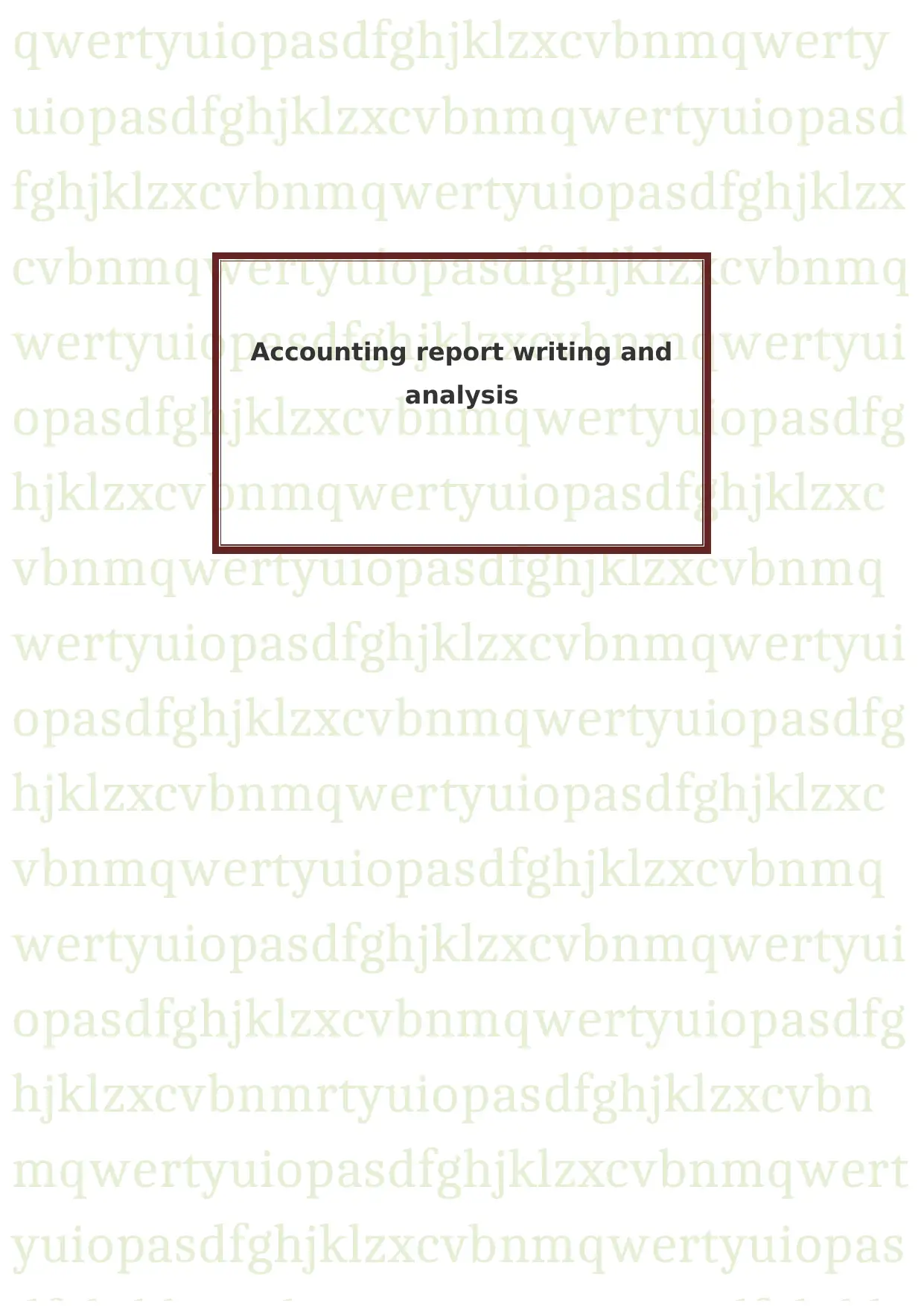
qwertyuiopasdfghjklzxcvbnmqwerty
uiopasdfghjklzxcvbnmqwertyuiopasd
fghjklzxcvbnmqwertyuiopasdfghjklzx
cvbnmqwertyuiopasdfghjklzxcvbnmq
wertyuiopasdfghjklzxcvbnmqwertyui
opasdfghjklzxcvbnmqwertyuiopasdfg
hjklzxcvbnmqwertyuiopasdfghjklzxc
vbnmqwertyuiopasdfghjklzxcvbnmq
wertyuiopasdfghjklzxcvbnmqwertyui
opasdfghjklzxcvbnmqwertyuiopasdfg
hjklzxcvbnmqwertyuiopasdfghjklzxc
vbnmqwertyuiopasdfghjklzxcvbnmq
wertyuiopasdfghjklzxcvbnmqwertyui
opasdfghjklzxcvbnmqwertyuiopasdfg
hjklzxcvbnmrtyuiopasdfghjklzxcvbn
mqwertyuiopasdfghjklzxcvbnmqwert
yuiopasdfghjklzxcvbnmqwertyuiopas
Accounting report writing and
analysis
uiopasdfghjklzxcvbnmqwertyuiopasd
fghjklzxcvbnmqwertyuiopasdfghjklzx
cvbnmqwertyuiopasdfghjklzxcvbnmq
wertyuiopasdfghjklzxcvbnmqwertyui
opasdfghjklzxcvbnmqwertyuiopasdfg
hjklzxcvbnmqwertyuiopasdfghjklzxc
vbnmqwertyuiopasdfghjklzxcvbnmq
wertyuiopasdfghjklzxcvbnmqwertyui
opasdfghjklzxcvbnmqwertyuiopasdfg
hjklzxcvbnmqwertyuiopasdfghjklzxc
vbnmqwertyuiopasdfghjklzxcvbnmq
wertyuiopasdfghjklzxcvbnmqwertyui
opasdfghjklzxcvbnmqwertyuiopasdfg
hjklzxcvbnmrtyuiopasdfghjklzxcvbn
mqwertyuiopasdfghjklzxcvbnmqwert
yuiopasdfghjklzxcvbnmqwertyuiopas
Accounting report writing and
analysis
Paraphrase This Document
Need a fresh take? Get an instant paraphrase of this document with our AI Paraphraser
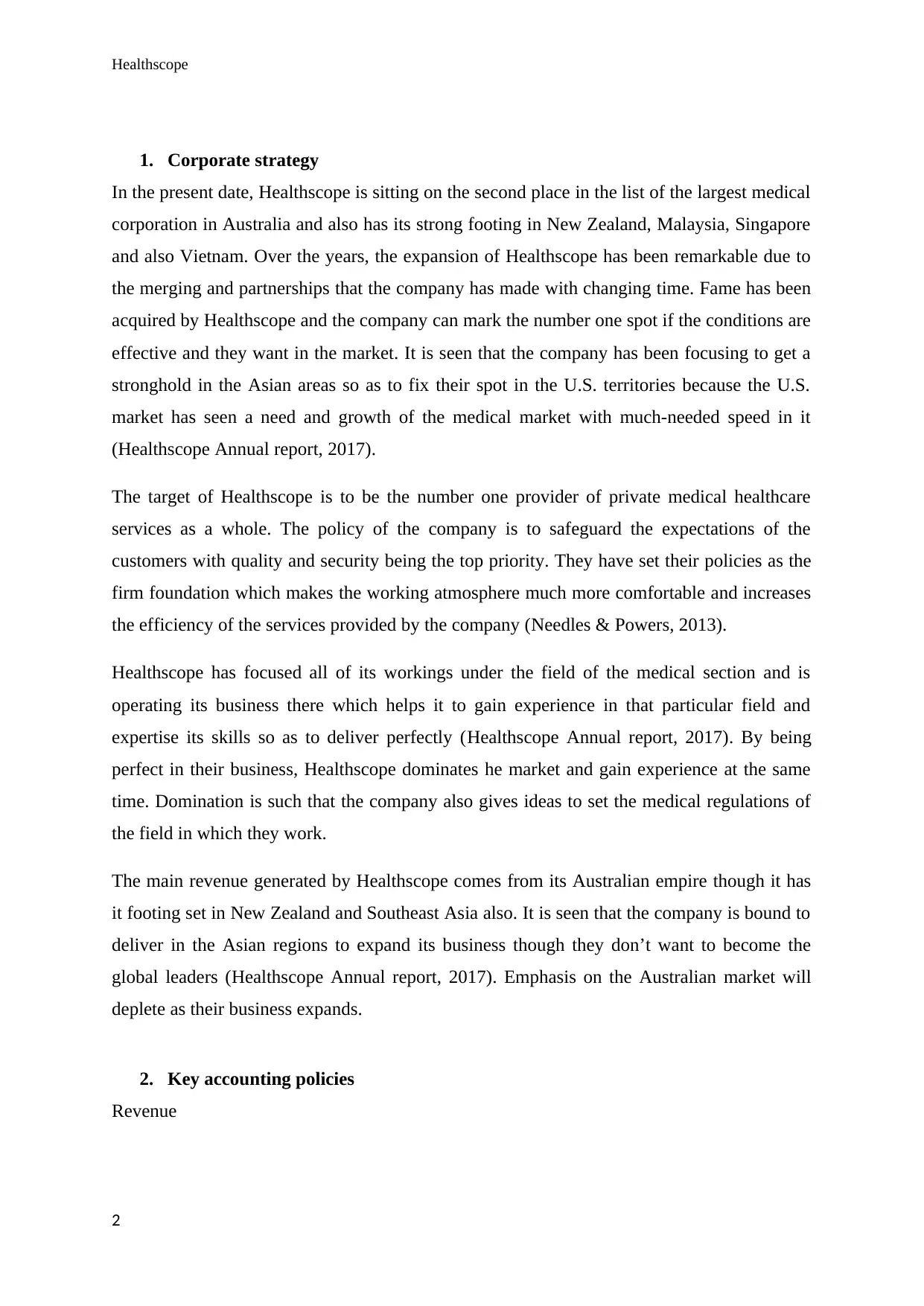
Healthscope
1. Corporate strategy
In the present date, Healthscope is sitting on the second place in the list of the largest medical
corporation in Australia and also has its strong footing in New Zealand, Malaysia, Singapore
and also Vietnam. Over the years, the expansion of Healthscope has been remarkable due to
the merging and partnerships that the company has made with changing time. Fame has been
acquired by Healthscope and the company can mark the number one spot if the conditions are
effective and they want in the market. It is seen that the company has been focusing to get a
stronghold in the Asian areas so as to fix their spot in the U.S. territories because the U.S.
market has seen a need and growth of the medical market with much-needed speed in it
(Healthscope Annual report, 2017).
The target of Healthscope is to be the number one provider of private medical healthcare
services as a whole. The policy of the company is to safeguard the expectations of the
customers with quality and security being the top priority. They have set their policies as the
firm foundation which makes the working atmosphere much more comfortable and increases
the efficiency of the services provided by the company (Needles & Powers, 2013).
Healthscope has focused all of its workings under the field of the medical section and is
operating its business there which helps it to gain experience in that particular field and
expertise its skills so as to deliver perfectly (Healthscope Annual report, 2017). By being
perfect in their business, Healthscope dominates he market and gain experience at the same
time. Domination is such that the company also gives ideas to set the medical regulations of
the field in which they work.
The main revenue generated by Healthscope comes from its Australian empire though it has
it footing set in New Zealand and Southeast Asia also. It is seen that the company is bound to
deliver in the Asian regions to expand its business though they don’t want to become the
global leaders (Healthscope Annual report, 2017). Emphasis on the Australian market will
deplete as their business expands.
2. Key accounting policies
Revenue
2
1. Corporate strategy
In the present date, Healthscope is sitting on the second place in the list of the largest medical
corporation in Australia and also has its strong footing in New Zealand, Malaysia, Singapore
and also Vietnam. Over the years, the expansion of Healthscope has been remarkable due to
the merging and partnerships that the company has made with changing time. Fame has been
acquired by Healthscope and the company can mark the number one spot if the conditions are
effective and they want in the market. It is seen that the company has been focusing to get a
stronghold in the Asian areas so as to fix their spot in the U.S. territories because the U.S.
market has seen a need and growth of the medical market with much-needed speed in it
(Healthscope Annual report, 2017).
The target of Healthscope is to be the number one provider of private medical healthcare
services as a whole. The policy of the company is to safeguard the expectations of the
customers with quality and security being the top priority. They have set their policies as the
firm foundation which makes the working atmosphere much more comfortable and increases
the efficiency of the services provided by the company (Needles & Powers, 2013).
Healthscope has focused all of its workings under the field of the medical section and is
operating its business there which helps it to gain experience in that particular field and
expertise its skills so as to deliver perfectly (Healthscope Annual report, 2017). By being
perfect in their business, Healthscope dominates he market and gain experience at the same
time. Domination is such that the company also gives ideas to set the medical regulations of
the field in which they work.
The main revenue generated by Healthscope comes from its Australian empire though it has
it footing set in New Zealand and Southeast Asia also. It is seen that the company is bound to
deliver in the Asian regions to expand its business though they don’t want to become the
global leaders (Healthscope Annual report, 2017). Emphasis on the Australian market will
deplete as their business expands.
2. Key accounting policies
Revenue
2
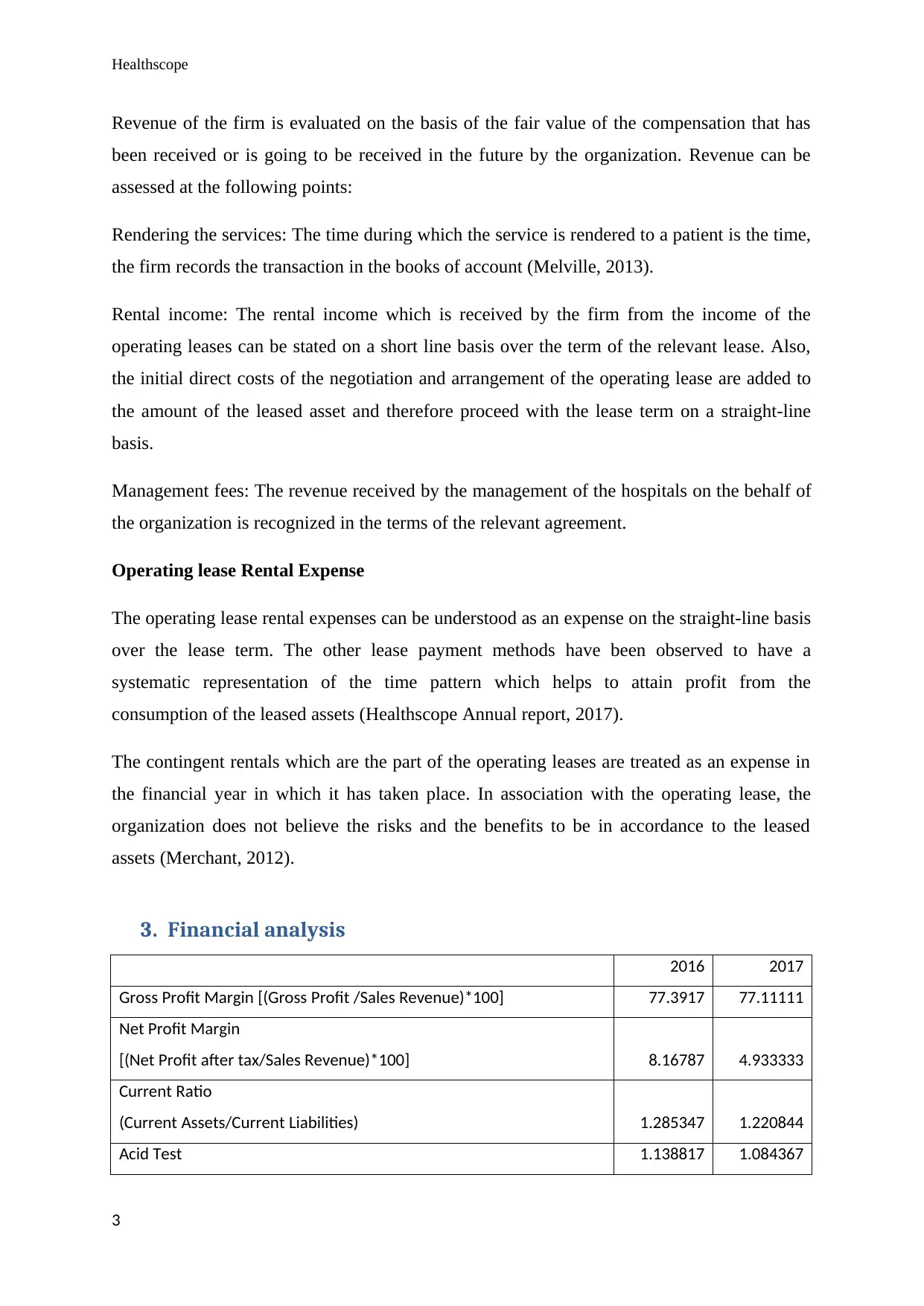
Healthscope
Revenue of the firm is evaluated on the basis of the fair value of the compensation that has
been received or is going to be received in the future by the organization. Revenue can be
assessed at the following points:
Rendering the services: The time during which the service is rendered to a patient is the time,
the firm records the transaction in the books of account (Melville, 2013).
Rental income: The rental income which is received by the firm from the income of the
operating leases can be stated on a short line basis over the term of the relevant lease. Also,
the initial direct costs of the negotiation and arrangement of the operating lease are added to
the amount of the leased asset and therefore proceed with the lease term on a straight-line
basis.
Management fees: The revenue received by the management of the hospitals on the behalf of
the organization is recognized in the terms of the relevant agreement.
Operating lease Rental Expense
The operating lease rental expenses can be understood as an expense on the straight-line basis
over the lease term. The other lease payment methods have been observed to have a
systematic representation of the time pattern which helps to attain profit from the
consumption of the leased assets (Healthscope Annual report, 2017).
The contingent rentals which are the part of the operating leases are treated as an expense in
the financial year in which it has taken place. In association with the operating lease, the
organization does not believe the risks and the benefits to be in accordance to the leased
assets (Merchant, 2012).
3. Financial analysis
2016 2017
Gross Profit Margin [(Gross Profit /Sales Revenue)*100] 77.3917 77.11111
Net Profit Margin
[(Net Profit after tax/Sales Revenue)*100] 8.16787 4.933333
Current Ratio
(Current Assets/Current Liabilities) 1.285347 1.220844
Acid Test 1.138817 1.084367
3
Revenue of the firm is evaluated on the basis of the fair value of the compensation that has
been received or is going to be received in the future by the organization. Revenue can be
assessed at the following points:
Rendering the services: The time during which the service is rendered to a patient is the time,
the firm records the transaction in the books of account (Melville, 2013).
Rental income: The rental income which is received by the firm from the income of the
operating leases can be stated on a short line basis over the term of the relevant lease. Also,
the initial direct costs of the negotiation and arrangement of the operating lease are added to
the amount of the leased asset and therefore proceed with the lease term on a straight-line
basis.
Management fees: The revenue received by the management of the hospitals on the behalf of
the organization is recognized in the terms of the relevant agreement.
Operating lease Rental Expense
The operating lease rental expenses can be understood as an expense on the straight-line basis
over the lease term. The other lease payment methods have been observed to have a
systematic representation of the time pattern which helps to attain profit from the
consumption of the leased assets (Healthscope Annual report, 2017).
The contingent rentals which are the part of the operating leases are treated as an expense in
the financial year in which it has taken place. In association with the operating lease, the
organization does not believe the risks and the benefits to be in accordance to the leased
assets (Merchant, 2012).
3. Financial analysis
2016 2017
Gross Profit Margin [(Gross Profit /Sales Revenue)*100] 77.3917 77.11111
Net Profit Margin
[(Net Profit after tax/Sales Revenue)*100] 8.16787 4.933333
Current Ratio
(Current Assets/Current Liabilities) 1.285347 1.220844
Acid Test 1.138817 1.084367
3
⊘ This is a preview!⊘
Do you want full access?
Subscribe today to unlock all pages.

Trusted by 1+ million students worldwide
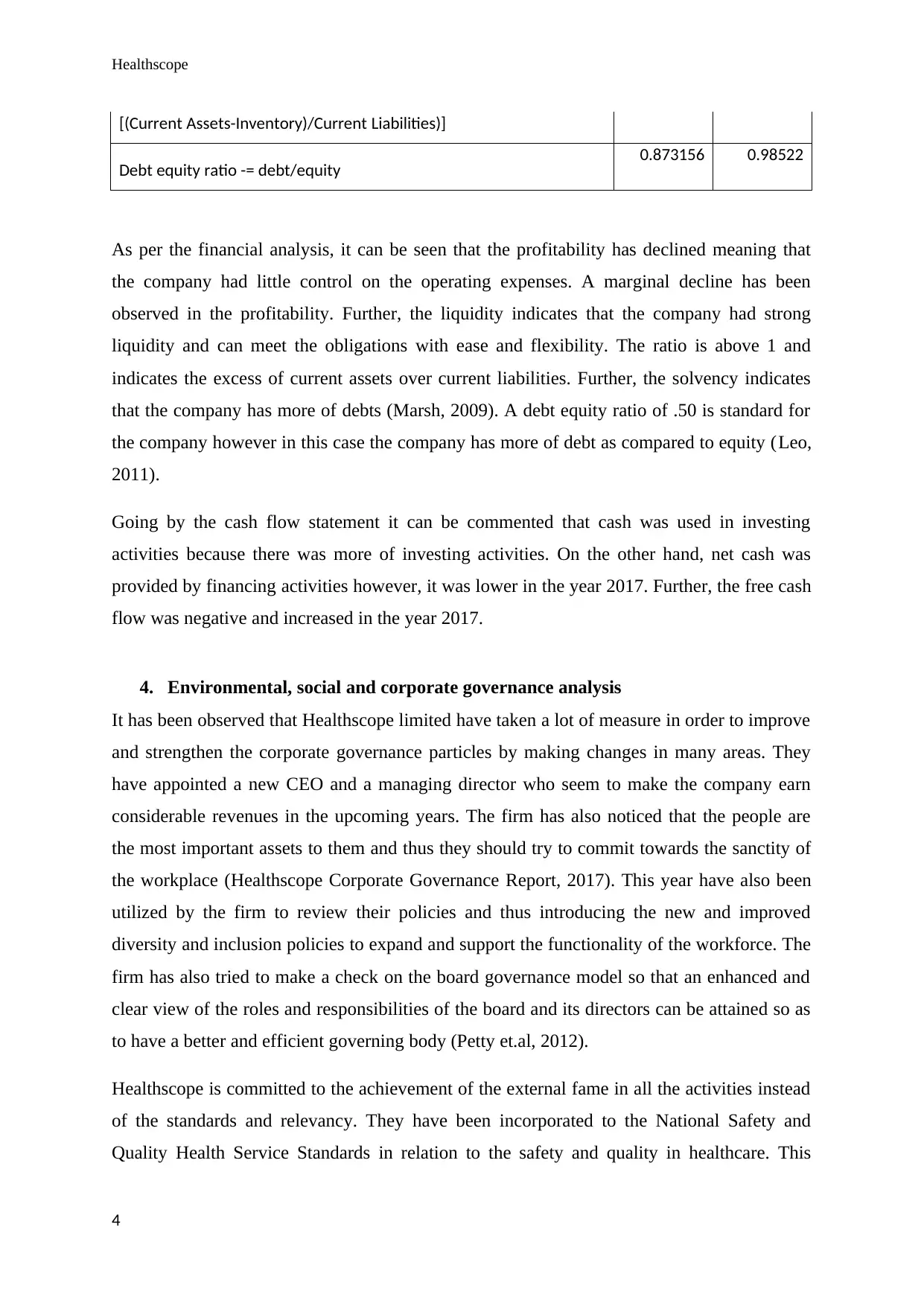
Healthscope
[(Current Assets-Inventory)/Current Liabilities)]
Debt equity ratio -= debt/equity 0.873156 0.98522
As per the financial analysis, it can be seen that the profitability has declined meaning that
the company had little control on the operating expenses. A marginal decline has been
observed in the profitability. Further, the liquidity indicates that the company had strong
liquidity and can meet the obligations with ease and flexibility. The ratio is above 1 and
indicates the excess of current assets over current liabilities. Further, the solvency indicates
that the company has more of debts (Marsh, 2009). A debt equity ratio of .50 is standard for
the company however in this case the company has more of debt as compared to equity (Leo,
2011).
Going by the cash flow statement it can be commented that cash was used in investing
activities because there was more of investing activities. On the other hand, net cash was
provided by financing activities however, it was lower in the year 2017. Further, the free cash
flow was negative and increased in the year 2017.
4. Environmental, social and corporate governance analysis
It has been observed that Healthscope limited have taken a lot of measure in order to improve
and strengthen the corporate governance particles by making changes in many areas. They
have appointed a new CEO and a managing director who seem to make the company earn
considerable revenues in the upcoming years. The firm has also noticed that the people are
the most important assets to them and thus they should try to commit towards the sanctity of
the workplace (Healthscope Corporate Governance Report, 2017). This year have also been
utilized by the firm to review their policies and thus introducing the new and improved
diversity and inclusion policies to expand and support the functionality of the workforce. The
firm has also tried to make a check on the board governance model so that an enhanced and
clear view of the roles and responsibilities of the board and its directors can be attained so as
to have a better and efficient governing body (Petty et.al, 2012).
Healthscope is committed to the achievement of the external fame in all the activities instead
of the standards and relevancy. They have been incorporated to the National Safety and
Quality Health Service Standards in relation to the safety and quality in healthcare. This
4
[(Current Assets-Inventory)/Current Liabilities)]
Debt equity ratio -= debt/equity 0.873156 0.98522
As per the financial analysis, it can be seen that the profitability has declined meaning that
the company had little control on the operating expenses. A marginal decline has been
observed in the profitability. Further, the liquidity indicates that the company had strong
liquidity and can meet the obligations with ease and flexibility. The ratio is above 1 and
indicates the excess of current assets over current liabilities. Further, the solvency indicates
that the company has more of debts (Marsh, 2009). A debt equity ratio of .50 is standard for
the company however in this case the company has more of debt as compared to equity (Leo,
2011).
Going by the cash flow statement it can be commented that cash was used in investing
activities because there was more of investing activities. On the other hand, net cash was
provided by financing activities however, it was lower in the year 2017. Further, the free cash
flow was negative and increased in the year 2017.
4. Environmental, social and corporate governance analysis
It has been observed that Healthscope limited have taken a lot of measure in order to improve
and strengthen the corporate governance particles by making changes in many areas. They
have appointed a new CEO and a managing director who seem to make the company earn
considerable revenues in the upcoming years. The firm has also noticed that the people are
the most important assets to them and thus they should try to commit towards the sanctity of
the workplace (Healthscope Corporate Governance Report, 2017). This year have also been
utilized by the firm to review their policies and thus introducing the new and improved
diversity and inclusion policies to expand and support the functionality of the workforce. The
firm has also tried to make a check on the board governance model so that an enhanced and
clear view of the roles and responsibilities of the board and its directors can be attained so as
to have a better and efficient governing body (Petty et.al, 2012).
Healthscope is committed to the achievement of the external fame in all the activities instead
of the standards and relevancy. They have been incorporated to the National Safety and
Quality Health Service Standards in relation to the safety and quality in healthcare. This
4
Paraphrase This Document
Need a fresh take? Get an instant paraphrase of this document with our AI Paraphraser
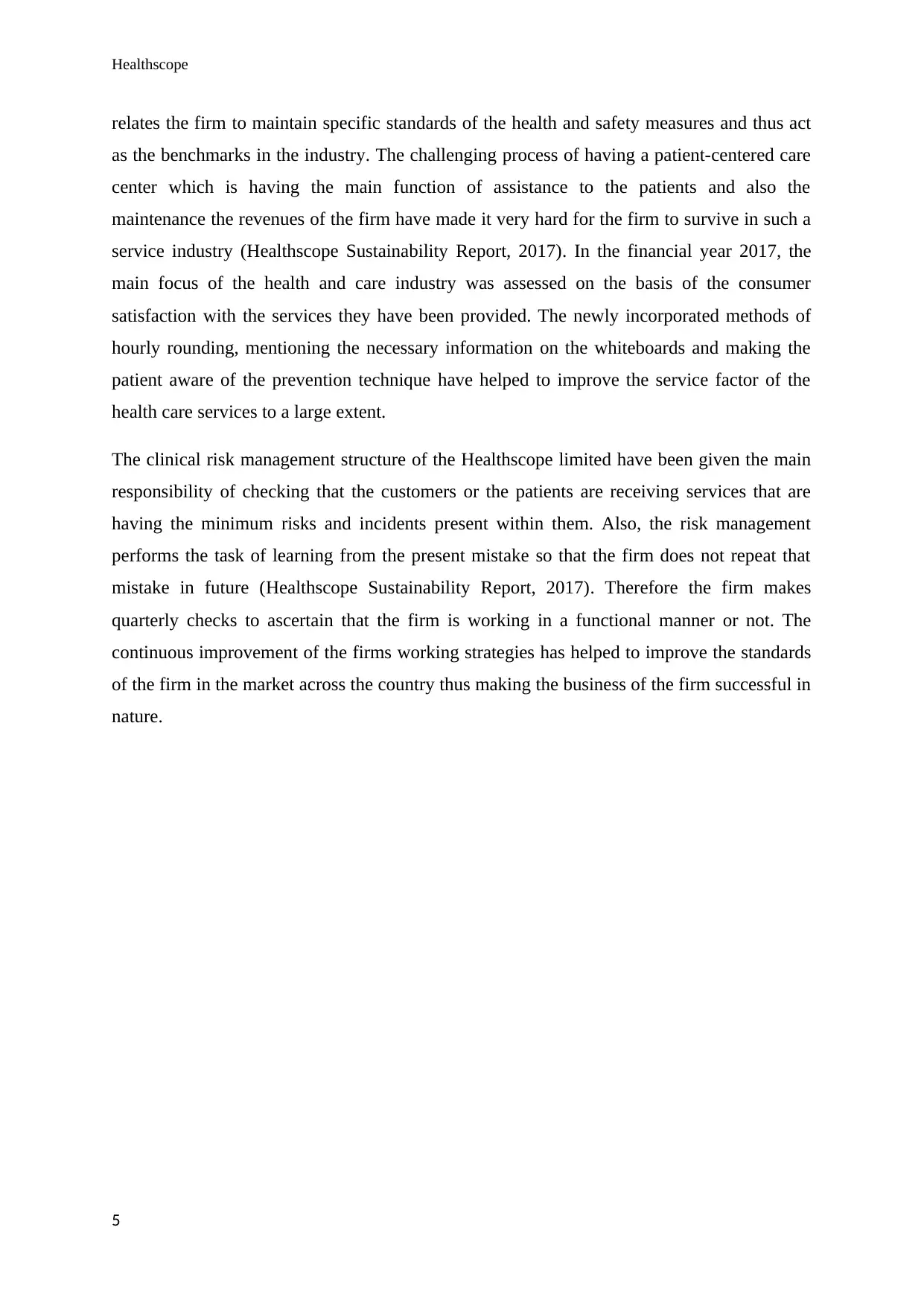
Healthscope
relates the firm to maintain specific standards of the health and safety measures and thus act
as the benchmarks in the industry. The challenging process of having a patient-centered care
center which is having the main function of assistance to the patients and also the
maintenance the revenues of the firm have made it very hard for the firm to survive in such a
service industry (Healthscope Sustainability Report, 2017). In the financial year 2017, the
main focus of the health and care industry was assessed on the basis of the consumer
satisfaction with the services they have been provided. The newly incorporated methods of
hourly rounding, mentioning the necessary information on the whiteboards and making the
patient aware of the prevention technique have helped to improve the service factor of the
health care services to a large extent.
The clinical risk management structure of the Healthscope limited have been given the main
responsibility of checking that the customers or the patients are receiving services that are
having the minimum risks and incidents present within them. Also, the risk management
performs the task of learning from the present mistake so that the firm does not repeat that
mistake in future (Healthscope Sustainability Report, 2017). Therefore the firm makes
quarterly checks to ascertain that the firm is working in a functional manner or not. The
continuous improvement of the firms working strategies has helped to improve the standards
of the firm in the market across the country thus making the business of the firm successful in
nature.
5
relates the firm to maintain specific standards of the health and safety measures and thus act
as the benchmarks in the industry. The challenging process of having a patient-centered care
center which is having the main function of assistance to the patients and also the
maintenance the revenues of the firm have made it very hard for the firm to survive in such a
service industry (Healthscope Sustainability Report, 2017). In the financial year 2017, the
main focus of the health and care industry was assessed on the basis of the consumer
satisfaction with the services they have been provided. The newly incorporated methods of
hourly rounding, mentioning the necessary information on the whiteboards and making the
patient aware of the prevention technique have helped to improve the service factor of the
health care services to a large extent.
The clinical risk management structure of the Healthscope limited have been given the main
responsibility of checking that the customers or the patients are receiving services that are
having the minimum risks and incidents present within them. Also, the risk management
performs the task of learning from the present mistake so that the firm does not repeat that
mistake in future (Healthscope Sustainability Report, 2017). Therefore the firm makes
quarterly checks to ascertain that the firm is working in a functional manner or not. The
continuous improvement of the firms working strategies has helped to improve the standards
of the firm in the market across the country thus making the business of the firm successful in
nature.
5
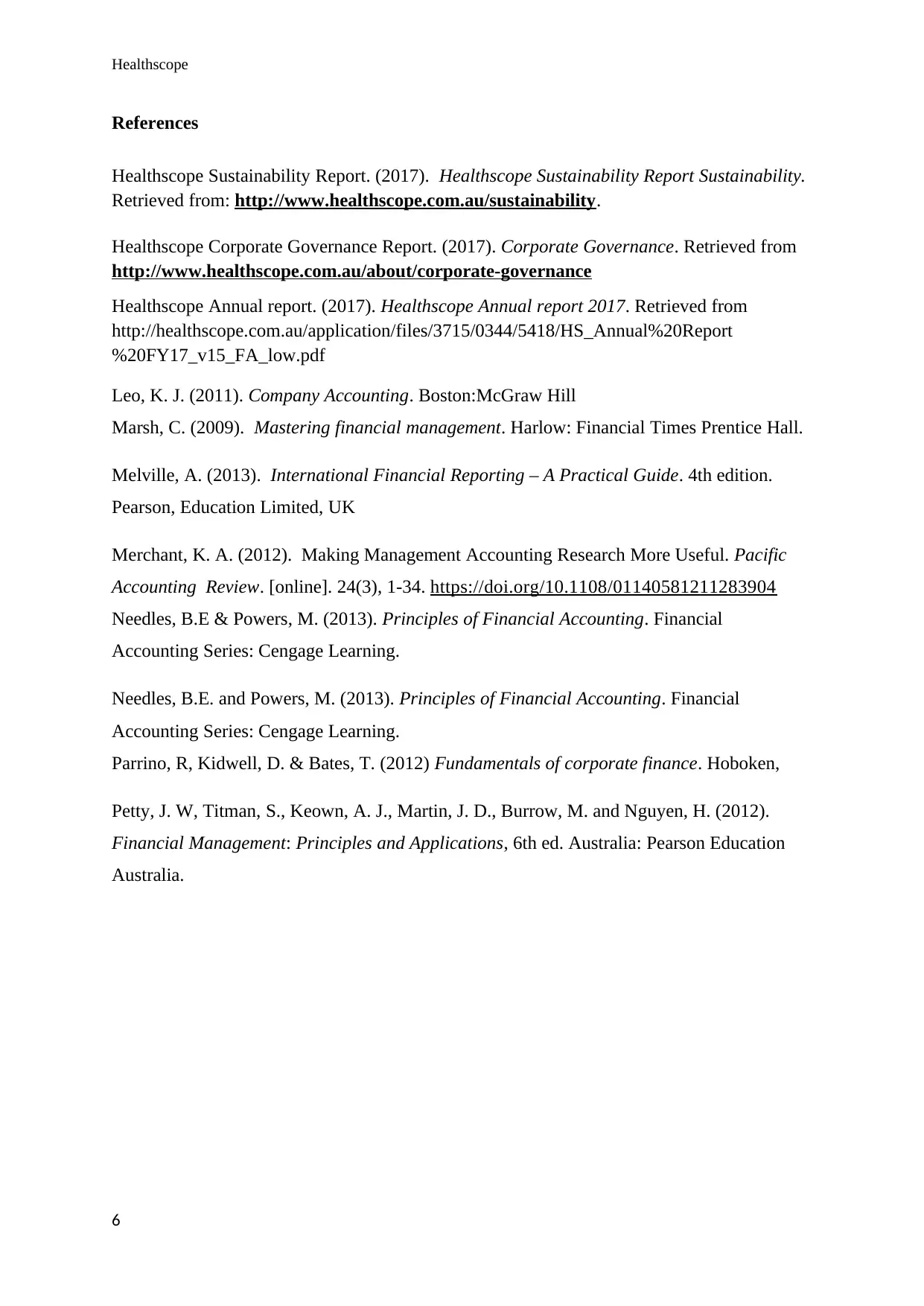
Healthscope
References
Healthscope Sustainability Report. (2017). Healthscope Sustainability Report Sustainability.
Retrieved from: http://www.healthscope.com.au/sustainability.
Healthscope Corporate Governance Report. (2017). Corporate Governance. Retrieved from
http://www.healthscope.com.au/about/corporate-governance
Healthscope Annual report. (2017). Healthscope Annual report 2017. Retrieved from
http://healthscope.com.au/application/files/3715/0344/5418/HS_Annual%20Report
%20FY17_v15_FA_low.pdf
Leo, K. J. (2011). Company Accounting. Boston:McGraw Hill
Marsh, C. (2009). Mastering financial management. Harlow: Financial Times Prentice Hall.
Melville, A. (2013). International Financial Reporting – A Practical Guide. 4th edition.
Pearson, Education Limited, UK
Merchant, K. A. (2012). Making Management Accounting Research More Useful. Pacific
Accounting Review. [online]. 24(3), 1-34. https://doi.org/10.1108/01140581211283904
Needles, B.E & Powers, M. (2013). Principles of Financial Accounting. Financial
Accounting Series: Cengage Learning.
Needles, B.E. and Powers, M. (2013). Principles of Financial Accounting. Financial
Accounting Series: Cengage Learning.
Parrino, R, Kidwell, D. & Bates, T. (2012) Fundamentals of corporate finance. Hoboken,
Petty, J. W, Titman, S., Keown, A. J., Martin, J. D., Burrow, M. and Nguyen, H. (2012).
Financial Management: Principles and Applications, 6th ed. Australia: Pearson Education
Australia.
6
References
Healthscope Sustainability Report. (2017). Healthscope Sustainability Report Sustainability.
Retrieved from: http://www.healthscope.com.au/sustainability.
Healthscope Corporate Governance Report. (2017). Corporate Governance. Retrieved from
http://www.healthscope.com.au/about/corporate-governance
Healthscope Annual report. (2017). Healthscope Annual report 2017. Retrieved from
http://healthscope.com.au/application/files/3715/0344/5418/HS_Annual%20Report
%20FY17_v15_FA_low.pdf
Leo, K. J. (2011). Company Accounting. Boston:McGraw Hill
Marsh, C. (2009). Mastering financial management. Harlow: Financial Times Prentice Hall.
Melville, A. (2013). International Financial Reporting – A Practical Guide. 4th edition.
Pearson, Education Limited, UK
Merchant, K. A. (2012). Making Management Accounting Research More Useful. Pacific
Accounting Review. [online]. 24(3), 1-34. https://doi.org/10.1108/01140581211283904
Needles, B.E & Powers, M. (2013). Principles of Financial Accounting. Financial
Accounting Series: Cengage Learning.
Needles, B.E. and Powers, M. (2013). Principles of Financial Accounting. Financial
Accounting Series: Cengage Learning.
Parrino, R, Kidwell, D. & Bates, T. (2012) Fundamentals of corporate finance. Hoboken,
Petty, J. W, Titman, S., Keown, A. J., Martin, J. D., Burrow, M. and Nguyen, H. (2012).
Financial Management: Principles and Applications, 6th ed. Australia: Pearson Education
Australia.
6
⊘ This is a preview!⊘
Do you want full access?
Subscribe today to unlock all pages.

Trusted by 1+ million students worldwide
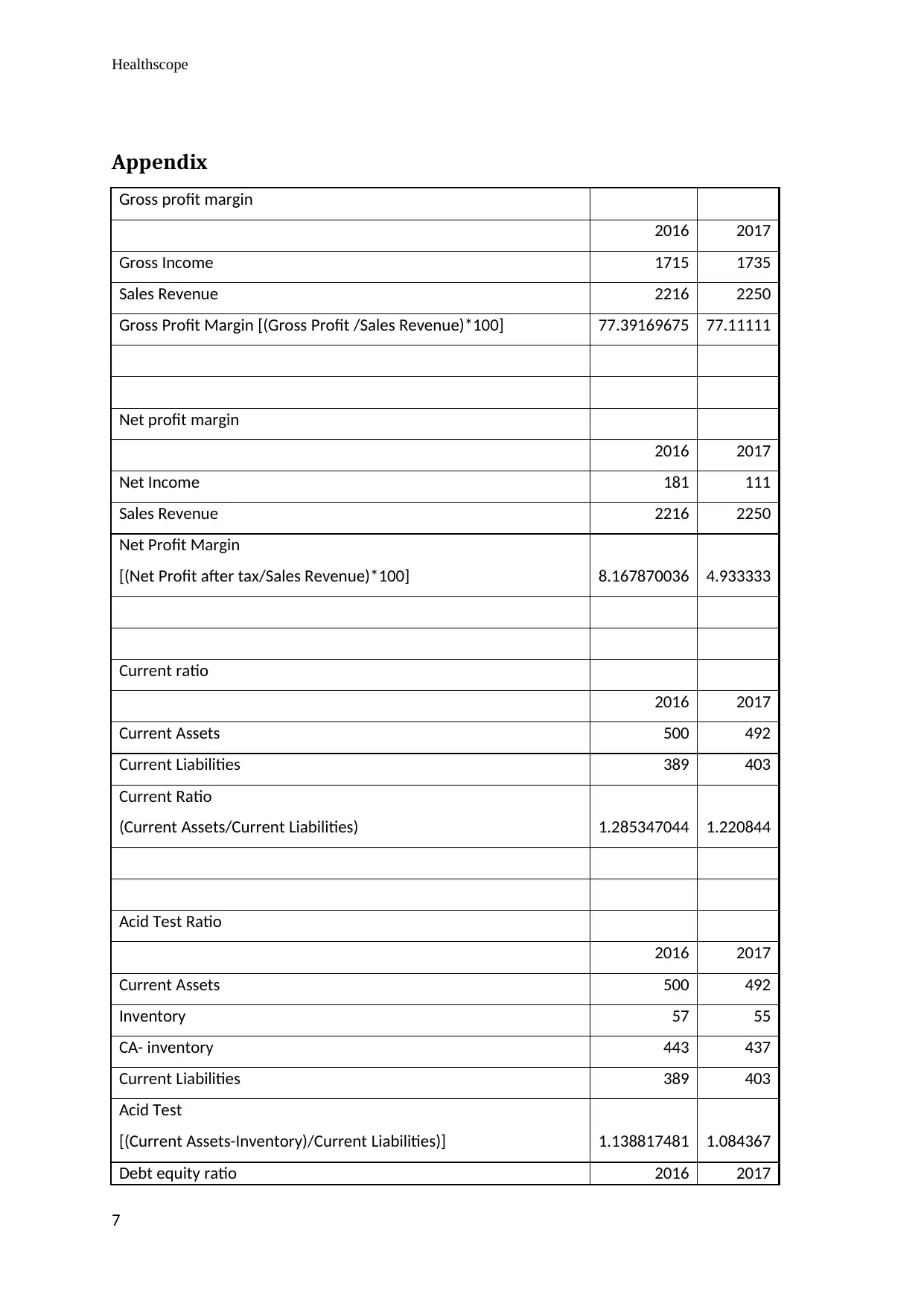
Healthscope
Appendix
Gross profit margin
2016 2017
Gross Income 1715 1735
Sales Revenue 2216 2250
Gross Profit Margin [(Gross Profit /Sales Revenue)*100] 77.39169675 77.11111
Net profit margin
2016 2017
Net Income 181 111
Sales Revenue 2216 2250
Net Profit Margin
[(Net Profit after tax/Sales Revenue)*100] 8.167870036 4.933333
Current ratio
2016 2017
Current Assets 500 492
Current Liabilities 389 403
Current Ratio
(Current Assets/Current Liabilities) 1.285347044 1.220844
Acid Test Ratio
2016 2017
Current Assets 500 492
Inventory 57 55
CA- inventory 443 437
Current Liabilities 389 403
Acid Test
[(Current Assets-Inventory)/Current Liabilities)] 1.138817481 1.084367
Debt equity ratio 2016 2017
7
Appendix
Gross profit margin
2016 2017
Gross Income 1715 1735
Sales Revenue 2216 2250
Gross Profit Margin [(Gross Profit /Sales Revenue)*100] 77.39169675 77.11111
Net profit margin
2016 2017
Net Income 181 111
Sales Revenue 2216 2250
Net Profit Margin
[(Net Profit after tax/Sales Revenue)*100] 8.167870036 4.933333
Current ratio
2016 2017
Current Assets 500 492
Current Liabilities 389 403
Current Ratio
(Current Assets/Current Liabilities) 1.285347044 1.220844
Acid Test Ratio
2016 2017
Current Assets 500 492
Inventory 57 55
CA- inventory 443 437
Current Liabilities 389 403
Acid Test
[(Current Assets-Inventory)/Current Liabilities)] 1.138817481 1.084367
Debt equity ratio 2016 2017
7
1 out of 7
Your All-in-One AI-Powered Toolkit for Academic Success.
+13062052269
info@desklib.com
Available 24*7 on WhatsApp / Email
![[object Object]](/_next/static/media/star-bottom.7253800d.svg)
Unlock your academic potential
Copyright © 2020–2025 A2Z Services. All Rights Reserved. Developed and managed by ZUCOL.

